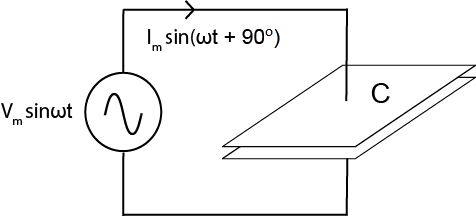This tool calculates a capacitor's reactance for a given capacitance value and signal frequency.
Output
Overview
Our capacitive reactance calculator helps you determine the impedance of a capacitor if its capacitance value (C) and the frequency of the signal passing through it (f) are given. You can input the capacitance in farads, microfarads, nanofarads, or picofarads. For the frequency, the unit options are Hz, kHz, MHz, and GHz.

Equation
$$X_{C} = \frac{1}{\omega C} = \frac{1}{2 \pi fC}$$
Where:
$$X_{C}$$ = capacitor reactance in ohms (Ω)
$$\omega$$ = angular frequency in rad/s = $$2 \pi f$$, where $$f$$ is the frequency in Hz
$$C$$ = capacitance in farads
Reactance (X) conveys a component's resistance to alternating current. Impedance (Z) conveys a component's resistance to both direct current and alternating current; it is expressed as a complex number, i.e., Z = R + jX. The impedance of an ideal resistor is equal to its resistance; in this case, the real part of the impedance is the resistance, and the imaginary part is zero. The impedance of an ideal capacitor is equal in magnitude to its reactance, but these two quantities are not identical. Reactance is expressed as an ordinary number with the unit ohms, whereas the impedance of a capacitor is the reactance multiplied by -j, i.e., Z = -jX. The -j term accounts for the 90-degree phase shift between voltage and current that occurs in a purely capacitive circuit.
The above equation gives you the reactance of a capacitor. To convert this to the impedance of a capacitor, simply use the formula Z = -jX. Reactance is a more straightforward value; it tells you how much resistance a capacitor will have at a certain frequency. Impedance, however, is needed for comprehensive AC circuit analysis.
As you can see from the above equation, a capacitor's reactance is inversely proportional to both frequency and capacitance: higher frequency and higher capacitance both lead to lower reactance. The inverse relationship between reactance and frequency explains why we use capacitors to block low-frequency components of a signal while allowing high-frequency components to pass.
Further Reading
Textbook - AC Capacitor Circuits
Textbook - Series Resistor-Capacitor Circuits






7 CommentsLogin
Since it calculates only Xc (which is NOT impedance), this is not a very useful tool. Who DOESN’T recall the formula for Xc?
Frequency can be entered in ONLY Hertz, making this tool not very user-friendly above audio frequencies. Those of us working into the GHz region would have to enter LOTS of zeros.
Impedance is the total resistance in ohms of any network at a specific frequency including both the real and imaginary of angular parts. Capacitors have a resistance that is totally imaginary with a vector of 90 degrees. The current lags the voltage by 90 degrees. An inductor is negative 90 degrees. Impedence includes all the resistances in a network along with the total phase shift introduced by all the components
Many of the “calculators” here are just simple formula solvers. That is not very flexible. What should be used is an equation solver wherein all the variable values that are known are input and the solver provides the unknown value. My simple HP calculator does that. AND, just like WA7PRC says, the input units are inconveniently limited. Use the computer for what it can do. X < > Y, Richard
Try and keep the word IMPEDANCE away from any discussion, dealing with capacitors as we use IMPEDANCE when discussing inductors and inductance.
You can possibly say “resistance” of a capacitor or “effective resistance” of a capacitor but keep away from IMPEDANCE.
I do not agree with that statement. A capacitor impedance is -j*XC and an inductor impedance is j*XL. Why would we stay away from impedance in this discussion when impedance “is” the discussion?
Impedance of a capacitive element; it is measured in ohms and is a measure of how much the capacitive element “controls or impedes” the level of current through the network. People that’s telling that he’s not calculating impedance can buzz off.
Saying that a capacitor has a resistance, as someone pointed out, is plain stupid. A capacitor has an impedance but you don’t really call it a resistance.
There is an issue with the calculator. It is solving for Xc, not impedance. If we put value 1uF and 1Hz into the calculator we get 159154.9431 ohm, but that is only Xc. The pure capacitor impedance (with Real=0) is actually -j*Xc, therefore, Z = -159154.9431j ohm.